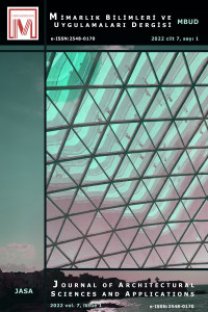Etnik Kümelenmelerin Tarihsel Dönüşümünün Sosyal Sermayeye ve Mekânsal Üretime Yansıması: Yahudi ve Rum Mahalleleri Örneği
Kamusal alan, Yahudi ve Rum mahalleleri, göç, dönüşüm
The Effect of Historical Transformation of Ethnic Clusters on Social Capital and Spatial Production: The Case of Jewish and Greek Neighborhoods
Public space, Jewish and Greek neighborhoods, immigration, transformation,
___
- Alesina, A. ve La Ferrara, E. (2005). Ethnic diversity and economic performance. Journal of Economic Literature, 43 (3), 762–800.
- Algan, Y., Hémet, C. ve Laitin, D. D. (2016). The social effects of ethnic diversity at the local level: A natural experiment with exogenous residential allocation. Journal of Political Economy, 124(3), 696–733.
- Assmann, J. ve Czaplicka, J. (1995). Collective memory and cultural ıdentity. New German Critique, 65, 125.
- Auge, M. (1996). Non-places: Introduction to an anthropology of supermodernity. Capital & Class, 20(3), 144–145.
- Bağımsız İletişim Ağı. (2021). Erişim adresi (10.11.2021):https://bianet.org/
- Bahar, B. L. (2003). Efsaneden Tarihe Ankara Yahudileri (Vol. 27). Pan Yayıncılık, İstanbul.
- Boratav, K. (2008). Türkiye İktisat Tarihi 1908-1985. İmge Kitapevi, İstanbul.
- Boschma, R. A. (2005). Proximity and innovation: A critical assessment. Regional Studies.
- Burt, R. S. (2017). Structural Holes versus Network Closure as Social Capital. Içinde Social Capital (ss. 31–56). Routledge.
- Chaix, B., Merlo, J., Evans, D., Leal, C., & Havard, S. (2009). Neighbourhoods in eco-epidemiologic research: delimiting personal exposure areas. A response to Riva, Gauvin, Apparicio and Brodeur. Social Science & Medicine, 69(9), 1306-1310.
- Coleman, J. S. (2009). H. Chapter 2. Knowledge and Social Capital, 17.
- Connerton, P. (1989). How Societies Remember. Cambridge University Press.
- Coser, L. A. (1992). Maurice Halbwachs: On Collective Memory. Içinde Heritage of Sociology.
- Çelik, Z. (2019). 19. Yüzyılda Osmanlı Başkenti Değişen İstanbul. Türkiye İş Bankası Kültür Yayınları, İstanbul.
- De Amicis, E. (1896). Constantinople.
- De Hammer, J. (1830). XXII. Memoir on the Diplomatic Relations between the Courts of Dehli and Constantinople in the Sixteenth and Seventeenth Centuries. Transactions of the Royal Asiatic Society of Great Britain and Ireland, 2(2), 462-486.
- Facebook. (2021). Erişim Tarihi: 12.12.2021, Erişim adresi: https://www.facebook.com/tatavladankurtulusa
- Google Earth. (2021). Erişim Tarihi: 12.10.2021, https://earth.google.com
- Gök, N. (2009). 19. yüzyıl ortalarında Ankara Yahudilerinin sosyal-iktisadi durumu. Osmanlı Tarihi Araştırma ve Uygulama Merkezi Dergisi OTAM, (26), 117-140.
- Hanlon, N. (2009). Social Capital. 10, 165–170.
- Hammer-Purgstall, J. V. (1822). Constantinopolis und der Bosporos. Reprint of.
- Hanlon, G. (2009). In Praise of Refeudalization: Princes and Feudataries in North-Central Italy from the Sixteenth to the Eighteenth Century. In Sociability and Its Discontents: Civil Society, Social Capital, and Their Alternatives in Late Medieval and Early Modern Europe (213-225).
- Hosanli, D. A. ve Altinöz, A. G. B. (2016). Ankara İsti̇klaL Yahudi̇ mahallesi̇: Tari̇hi̇, dokusu ve konutları. TÜBA-KED Türkiye Bilimler Akademisi Kültür Envanteri Dergisi, (14), 71
- Hristodulu, M. (2013). Tatavla Tarihi. İstos Yayınları, İstanbul.
- Irmak, H. (2018). Tatavla’dan Kurtuluş’a. Aras Yayınları, İstanbul.
- İlter, F. (1996). Ankara’nın eski kent dokusunda Yahudi Mahallesi ve Sinagog. Belleten-Türk Tarih Kurumu, 60(229), 719-743
- İzmir Jewish Heritage Project. (2021). Erişim adresi (12.12.2021):http://www.izmirjh.com/ana-sayfa/birinci-yahudi-mahallesi/havra-sokagi/
- Karavia, I. N. (1933). Allote Ke Tora, İstanbul.
- Kemeraltı Çarşısı Web Sitesi. (2021). Erişim adresi (12.12.2021):http://e-kemeralti.com/havra-sokagi-bir-cazibe-merkeziydi/
- Kesler, C. ve Bloemraad, I. (2010). Does immigration erode social capital? the conditional effects of immigration-generated diversity on trust, membership, and participation across 19 countries, 1981-2000. Canadian Journal of Political Science, 43(2), 319–347.
- Lin, N. (2002). Social capital: A theory of social structure and action (Vol. 19). Cambridge University press.
- Marion, C. F. (2019). 1890’larda İstanbul. Türkiye İş Bankası Kültür Yayınları.
- Marion-Crawford, F. (1890). 1890’larda İstanbul. Türkiye İş Bankası Kültür Yayınları, 3, 49.
- Ostrom, E. (1990). Governing the commons: the evolution of institutions for collective action.
- Pervititch Haritası. (1929).
- Putnam, R. D. (1993). What makes democracy work?. National Civic Review, 82(2), 101-107.
- Shaw, S. J. (1970). The central legislative councils in the nineteenth century ottoman reform movement before 1876. International Journal of Middle East Studies, 1(1), 51–84.
- Spataris, H. (2011). Biz İstanbullular Böyleyiz. Kitap Yayınevi, İstanbul.
- Sosyal Hizmetler Uzmanı. (2021). Yahudilerin Yok Olan Tarihsel Mirası: Kortejo Evleri. Erişim Tarihi: 11.11.2021, https://www.sosyalhizmetuzmani.org/kortejaevleri.htm
- Şenocak, B. (2003). Levant'ın Yıldızı İzmir: Levantenler, Rumlar, Ermeniler ve Yahudiler (Vol. 1). Şenocak Kültür Yayınları, İzmir.
- Şenyurt, O. (2012). Osmanlı Rum Cemaatinin Osmanlı Mimarisindeki Temsiliyeti. Doğu Kitapevi, İstanbul.
- Türker, O. (2009). Osmanlı İstanbul’undan Bir Köşe Tatavla. Sel Yayıncılık, İstanbul.
- Türkiye İstatistik Kurumu, (TÜİK). (2021). Türkiye’de Kentsel ve Kırsal Nüfus Verileri. Erişim Adresi (12.12.2021):http://tuik.gov.tr/
- Yalçın, V. Yahudilerin Yok Olan Tarihsel Mirası: Kortejo Evleri. Erişim Adresi (09.10.2021): https://www.sosyalhizmetuzmani.org/kortejaevleri.htm
- Zeren, M. T. (2019). İzmir’de Seferad Mimarisi̇ ve Sinagoglari. Yalın Yayıncılık, İstanbul.
- Yayın Aralığı: Yılda 2 Sayı
- Başlangıç: 2016
- Yayıncı: Atila GÜL
Covid-19 Pandemisi Öncesi ve Sürecinde Kentsel Yeşil Alanlardaki Sosyal İlişkilerin İncelenmesi
Fenerbahçe Mahallesi Halkının İklim Değişikliğinin Kentsel Etkilerine Dair Farkındalıkları
Karaçi Kenti Ulaşım Sisteminin Sürdürülebilirlik Sütunlarının Analizi
Sania SİDDİQUİ, Şirin Gülcen EREN
Mekânsal Deneyimlerde Sinestezi (Çoklu Duyusal Algı) Kavramı ve Teknolojiyle Değişiminin İncelenmesi
Okan ŞİMŞEK, Sevgin Aysu BALKAN, Arife KOCA
Mikro Konutlarda Sürdürülebilirlik Yaklaşımı
Markov Tahmin Modelinin Testi: Isparta Örneği
Jesugbemi Olaoye AJİBOYE, Şirin Gülcen EREN, Andrew Ayangeaor UGESE
Bina Yönetmelik Uygunluk Kontrolü Sürecinde Bina Projesine Ait Verilerin Gösterimleri
Isparta’da Kooperatif Konut Alanları İçeren Mahallelerde Morfolojik Bir İnceleme
Deneyim Mekânları: Oyun-Öğrenme İlişkisi Çerçevesinde Vitrahaus
Merve KARAOĞLU CAN, Nuriye Nida ÇELEBİ ŞEKER
